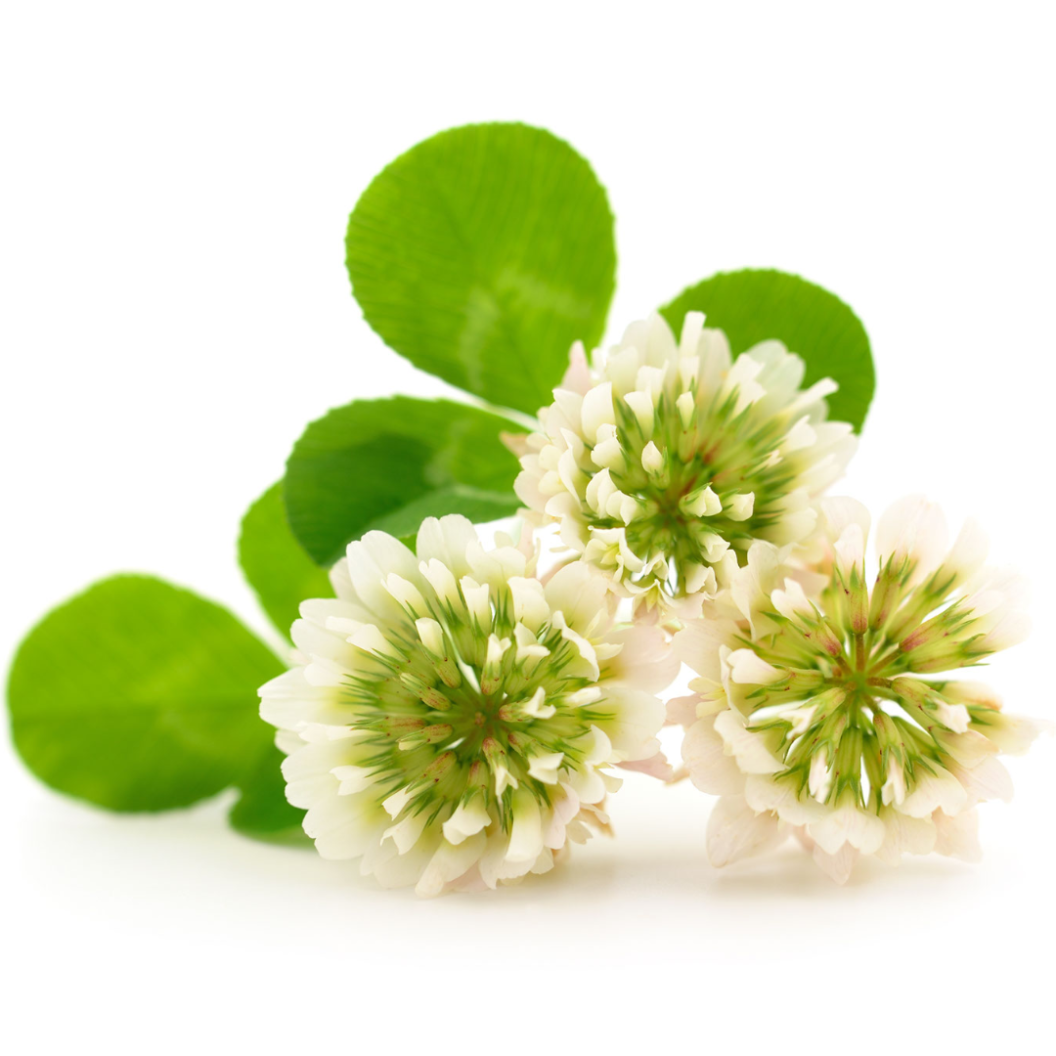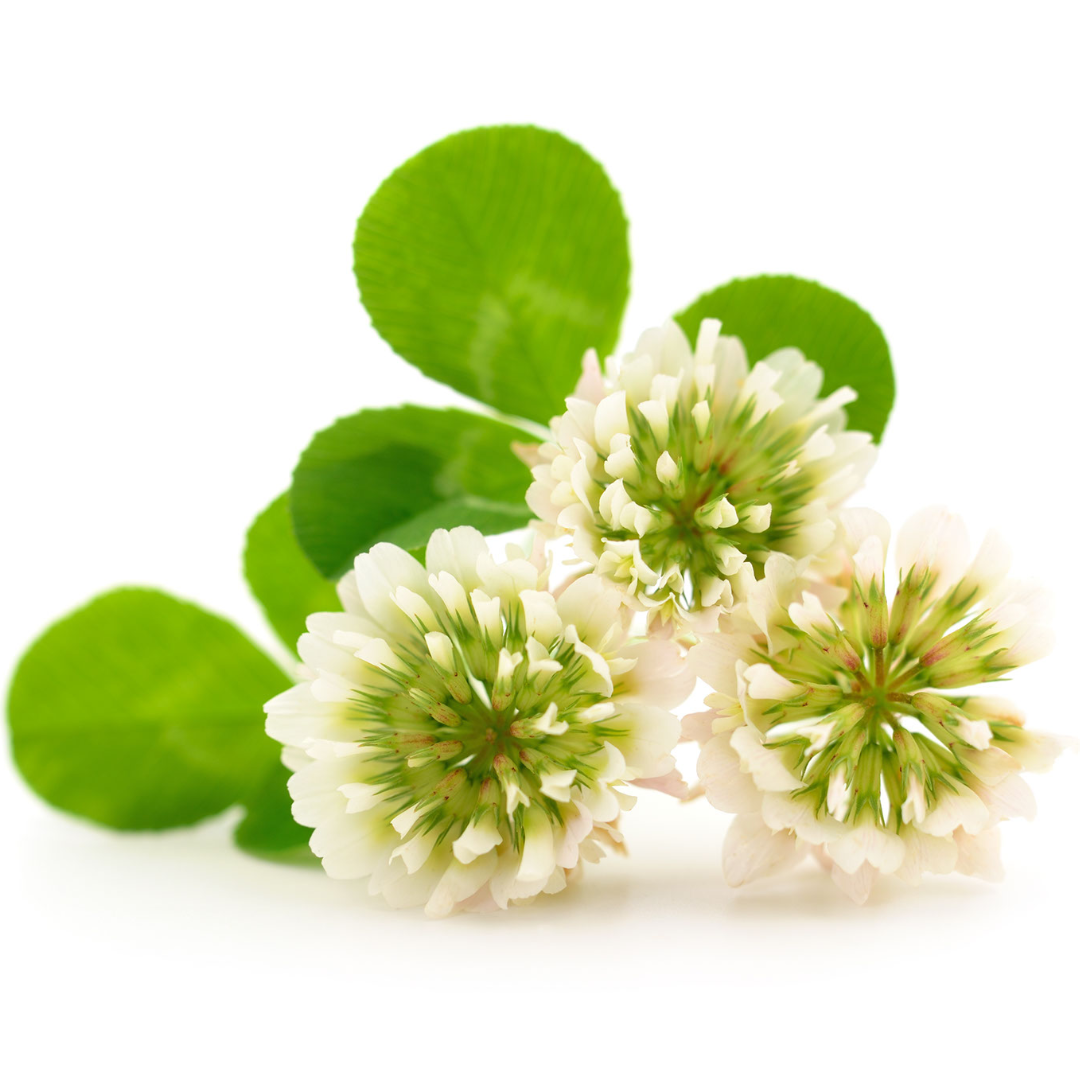
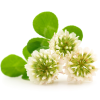

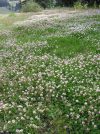

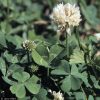
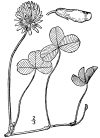
White Clover
DESCRIPTION: White clover, also known as "shamrock," is a small plant with leaves made up of three small leaflets that are usually white or light green in color. It often grows in patches in lawns or fields and is easily recognizable by its distinctive shape. White clover is known for attracting bees and other pollinators with its sweet nectar, and is sometimes used as a natural fertilizer due to its ability to fix nitrogen in the soil. It's a common sight in many parts of the world and is often associated with good luck and St. Patrick's Day celebrations.
SCIENTIFIC NAME: Trifolium repens
OTHER NAMES: Dutch Clover, Ladino Clover, Shamrock
LEAF TYPE: Broadleaf
FLOWERS: White clover flowers are small and delicate, and they form in clusters at the top of long, thin stems. Each flower consists of a round, white or pinkish globe made up of many tiny individual flowers, which give it a fuzzy appearance. The globe is surrounded by three heart-shaped petals, which are often tinged with pink or purple at the base. When the flowers are in bloom, they attract bees and other pollinators with their sweet scent and nectar. Overall, the flowers have a simple yet charming beauty that adds to the plant's appeal.
LEAVES: White clover has leaves that are made up of three small leaflets, each one resembling a tiny, heart-shaped leaf. The leaflets are usually a light green color, and they are soft and slightly fuzzy to the touch. They grow on long, thin stems that radiate out from the center of the plant, creating a circular pattern. The leaves have a slightly sweet smell, especially when they are freshly cut or crushed. Overall, the leaves have a simple yet pleasing appearance, and they are an important feature of the plant's overall shape and texture.
LIFE CYCLE: Perennial
HOW TO IDENTIFY: White clover is relatively easy to identify because of its distinct three-leafed pattern, which is often associated with the symbol of the Irish shamrock. Its leaves grow on long, thin stems and each leaf has three small, heart-shaped leaflets that are light green in color. The plant grows to about 6-8 inches in height, and it often forms large patches in lawns or fields. In the summer months, it produces clusters of small, white or pinkish flowers that are easily recognizable by their round, fuzzy shape. When in bloom, the flowers attract bees and other pollinators, making them another helpful identifying feature. Overall, the combination of the three-leafed pattern, light green leaves, and fuzzy white flowers make white clover a distinctive and easily identifiable plant.
MECHANICAL CONTROL RECOMMENDATIONS:
1. Hand pulling - More Info
2. Mowing - More Info
3. Tilling - More Info
4. Mulching - More Info
5. Solarization - More Info
6. Flame Weeding - More Info
7. Lawn renovation - More Info
8. Manual Removal Tools - More Info
It's essential to remember that mechanical control alone may not entirely eliminate Poa annua, especially in areas where the grass is actively managed, like golf courses and sports fields. Combining mechanical methods with chemical control and cultural practices can offer more effective long-term management. Always follow best practices and local regulations when using herbicides or pesticides. For large-scale control efforts, it's a good idea to consult with a professional turfgrass manager or horticulturist.
CHEMISTRY RECOMMENDATIONS:
"Pre-emergent herbicides:
Isoxaben: This herbicide inhibits cell wall synthesis in germinating weed seeds. It's often used to control broadleaf weeds like Trifolium repens. Products containing isoxaben are typically applied as granules or in liquid form.
Pendimethalin: This herbicide forms a barrier in the soil that prevents weed seeds from germinating. It's effective against a variety of annual grasses and broadleaf weeds, including Trifolium repens.
Prodiamine: Prodiamine is another pre-emergent herbicide that works by inhibiting cell division in germinating weed seeds. It's commonly used to control annual grasses and some broadleaf weeds, including white clover.
Dithiopyr: This herbicide prevents cell division and elongation in germinating weed seeds. It's effective against a range of annual grasses and broadleaf weeds, making it suitable for controlling Trifolium repens.
Oxadiazon: Oxadiazon inhibits the growth of germinating weed seeds by disrupting cell division. It can be used to control various annual grasses and broadleaf weeds, including white clover.
Benefin + Trifluralin: This combination of herbicides provides a broad-spectrum pre-emergent control against various weed seeds, including Trifolium repens.
Post-emergent herbicides:
2,4-D: This is a selective herbicide that primarily targets broadleaf weeds like Trifolium repens. It's commonly used in lawn care products and can help control white clover.
Dicamba: Another selective herbicide, dicamba is effective against many broadleaf weeds, including Trifolium repens. It's often used in combination with other herbicides for enhanced control.
Clopyralid: This herbicide is specifically formulated to control clover and other legume weeds. It's commonly used in turfgrass and non-crop settings.
MCPA: Similar to 2,4-D, MCPA is a selective herbicide that targets broadleaf weeds. It can help control Trifolium repens in lawns and other managed areas.
Glyphosate: Glyphosate is a non-selective herbicide that kills most types of plants, including Trifolium repens. It should be used with caution in areas where you want to preserve desirable plants, as it can affect both weeds and non-weeds.
Quinclorac: While primarily used to control annual grasses, quinclorac can also have activity against some broadleaf weeds, including white clover.
Selective herbicides:
Clopyralid: This herbicide is known for its effectiveness against clover and other legume weeds. It's relatively selective and can provide good control of Trifolium repens without harming grasses in lawns.
MCPA: MCPA is a broadleaf herbicide that targets many common broadleaf weeds, including white clover. It's selective for broadleaf plants and is often used in lawns.
Triclopyr: While not as specific to clover, triclopyr is known to have some activity against broadleaf weeds like Trifolium repens. It's commonly used in broadleaf herbicide formulations.
Dicamba: Dicamba is effective against various broadleaf weeds, including clover. It's used in selective herbicide products for lawns and landscapes.
2,4-D: This is one of the most widely used selective herbicides for controlling broadleaf weeds, including white clover, in lawns.
Quinclorac: Although mainly used to control annual grasses, quinclorac can also have some efficacy against certain broadleaf weeds like Trifolium repens.
Non-Selective herbicides:
Glyphosate: Glyphosate is one of the most commonly used non-selective herbicides. It effectively kills most types of plants, including Trifolium repens. However, it's essential to avoid spraying it on desirable plants, as it can cause significant damage.
Glufosinate: Glufosinate is another non-selective herbicide that can be used to control a wide range of weeds, including Trifolium repens. Like glyphosate, it should be used with care to avoid damaging non-target plants.
Paraquat: Paraquat is a fast-acting herbicide that damages plant cells upon contact, leading to rapid desiccation and death. It's often used in non-selective weed control.
Recommended Prevention
Recommended Control

